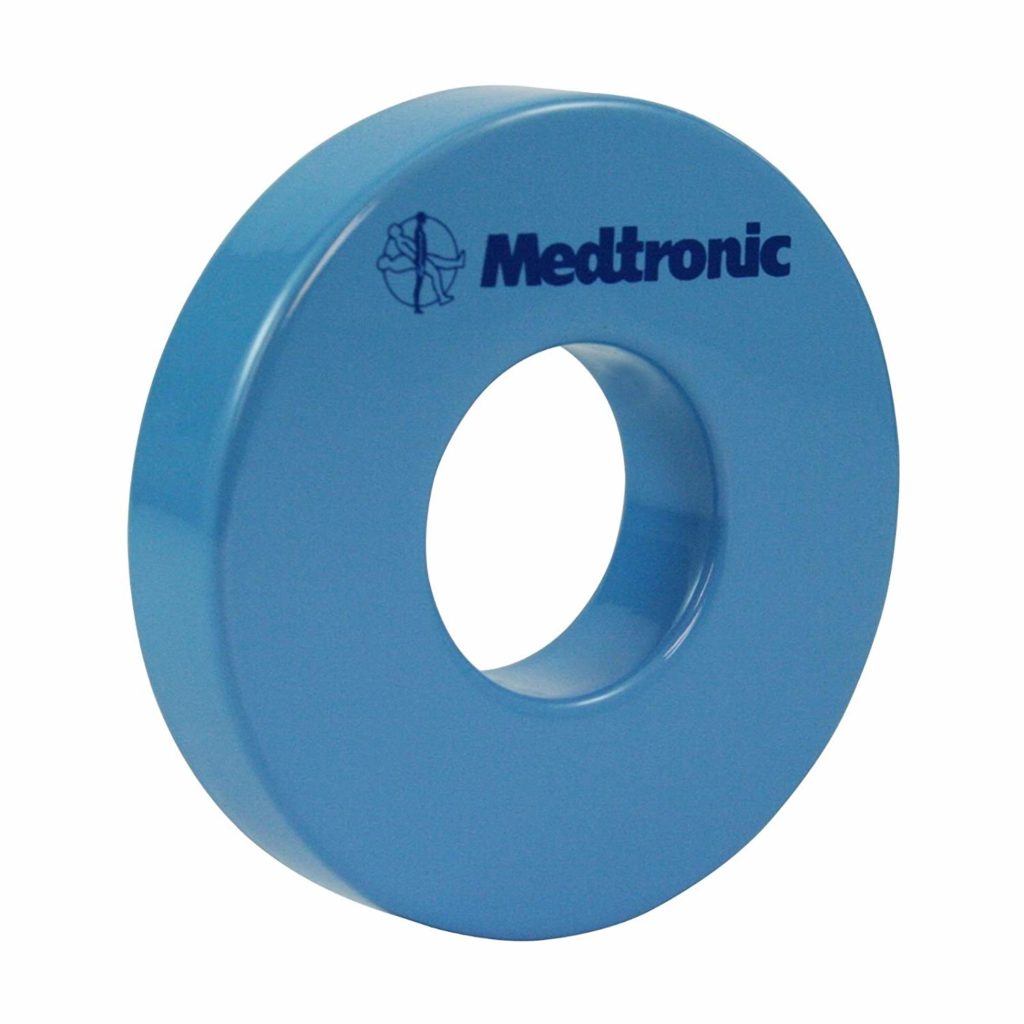Author: RK MD
With the number of patients receiving permanent pacemakers (PPMs) and implantable cardioverter-defibrillators (ICDs) increasing each year, we’ll see more of these devices in our respective clinical settings. With this post, I’ll try to simplify pacemaker nomenclature (ie, DDDR or AOO) and the implications of placing the magnet.
All ICDs have a pacemaker function but NOT all pacemakers are ICDs. Most patients should carry cards with information about their device, but when it’s 2 AM and your patient is found down, a chest x-ray can help you determine the type of device (PPM vs AICD) based on where the pacer leads are located and the presence of a thicker defibrillating lead only found in ICDs. It’s important to know the patient’s underlying rhythm (ie, what do they do without their pacer) and the indication for the PPM/ICD in the first place. Also, all pacers have a minimum backup rate which is the threshold heart rate at which the pacer will kick in.
When in doubt or confused, call your friends in electrophysiology!
Pacemaker nomenclature is most often written as a series of three letters (ie, VVI) but can be as much as five (DDDRO). I’m going to keep things simple! In order, the 3 or 5 letter nomenclature stands for:
- Chamber Paced: A (atrium), V (ventricle), D (dual)
- Chamber Sensed: A (atrium), V (ventricle), D (dual)
- Response to Sensed Beat: I (inhibit), T (trigger), D (dual), O (none)
- Rate Responsiveness: R (rate responsive), O (none)
- Automatically increases the pacing (and cardiac output) to meet an increase in exertion
- Multisite Pacing: O (none), A (atrium), V (ventricle), D (dual)
For most of us, only the first three characters matter.
SINGLE CHAMBER
A single electrode is fed into either the right atrium (“A wire”) or right ventricle (“V wire”). Now let’s consider some basic nomenclature using the aforementioned patterns.
- AAI: The atrium is paced and sensed. If an intrinsic beat is detected (ie, the patient’s SA node fires), the pacemaker will inhibit itself. This makes sense in conditions like sick sinus syndrome (SSS) where the AV node is working fine and cardiac output can be maintained as long as the atria are firing at an appropriate rate.
- VVI: The ventricle is paced and sensed. If an intrinsic beat is detected (ie, conduction carried down through AV node into the ventricle), the pacemaker will inhibit itself. One can imagine that if the pacer has to constantly fire on the ventricle, some of the signal can be conducted retrograde into the atria during systole causing contraction against the closed tricuspid/mitral valves. Also, ventricular pacing causes the “atrial kick” to disappear which can have severe consequences in patients with poorly compliant ventricles requiring higher filling pressures.
DUAL CHAMBER
A wire is fed into the right atrium AND right ventricle. DDD is the most common mode I work with. In this setting, the pacemaker can independently sense and pace one or both of the chambers. Because of this, the patient’s EKG can show several rhythms:
- Sinus rhythm: The patient’s native heart rate is faster than the backup rate of the pacemaker. There is normal atrioventricular conduction.
- A sensed, V paced
- A paced, V sensed
- AV pacing: both chambers are paced
Now let’s briefly discuss pacemaker mode switching. If a patient with a DDD dual chamber pacemaker suddenly develops an atrial tachyarrhythmia (atrial rates can exceed 500 bpm), it doesn’t make sense for the pacemaker to fire the ventricle at that rate. Instead, it’ll detect the fast atrial activity and “switch” into a safer mode (like VVI) to basically ignore atrial activity.
ICDs
Implantable cardioverter-defibrillators (ICDs) are placed for a myriad of reasons ranging from low ejection fraction states and sustained ventricular tachycardia/fibrillation to prior cardiac arrest from channelopathies or structural heart issues like hypertrophic cardiomyopathy. Remember, ALL ICDs have an intrinsic pacemaker function. The question is whether or not the patient is truly “pacer dependent.” This is where recent interrogation reports are important.
MAGNET
Keeping it simple: a magnet will reprogram a regular pacemaker into an asynchronous mode (AOO, VOO, DOO) at a manufacturer-defined heart rate. An ICD’s antitachycardia function will be disabled (ie, it will no longer deliver shocks); however, the pacemaker portion of the ICD will not be changed.
This is the question I’m often asked as a cardiothoracic anesthesiologist and intensivist.
“Rishi, I have a patient with (insert device name here)… do I need to put a magnet on?”
My first questions are:
- Why does the patient have the device?
- Is he/she “pacer dependent?”
- What’s the surgery? Is electrocautery involved? Are the surgeons working near the chest?
In my specialty, the most common situation I run into is a patient with an ICD coming in for cardiothoracic surgery. The device is located in the surgical field and, often times, will be explanted (ie, at the end of a heart transplant). As mentioned above, a sterile magnet will disable the ICD’s shock function but not affect the pacemaker function. If the patient is also pacer dependent, electrocautery in the field can be misinterpreted as intrinsic cardiac conduction system activity. The pacemaker portion will think the patient’s heart is firing on its own (when in reality, it’s the electrocautery), and the device will therefore inhibit itself. Now the patient’s true heart rate will become apparent which can significantly drop the cardiac output leading to bradycardia/bradyarrhythmias and hypotension.
If you feel like this is a potential scenario in your situation, the safest option is to have the electrophysiology team come reprogram the device to an asynchronous mode prior to surgery. Although I usually also place external defibrillator pads on these patients, remember that if they go into a “shockable rhythm” intraoperatively (ie, VFib), just remove the magnet and let the ICD function kick in.


